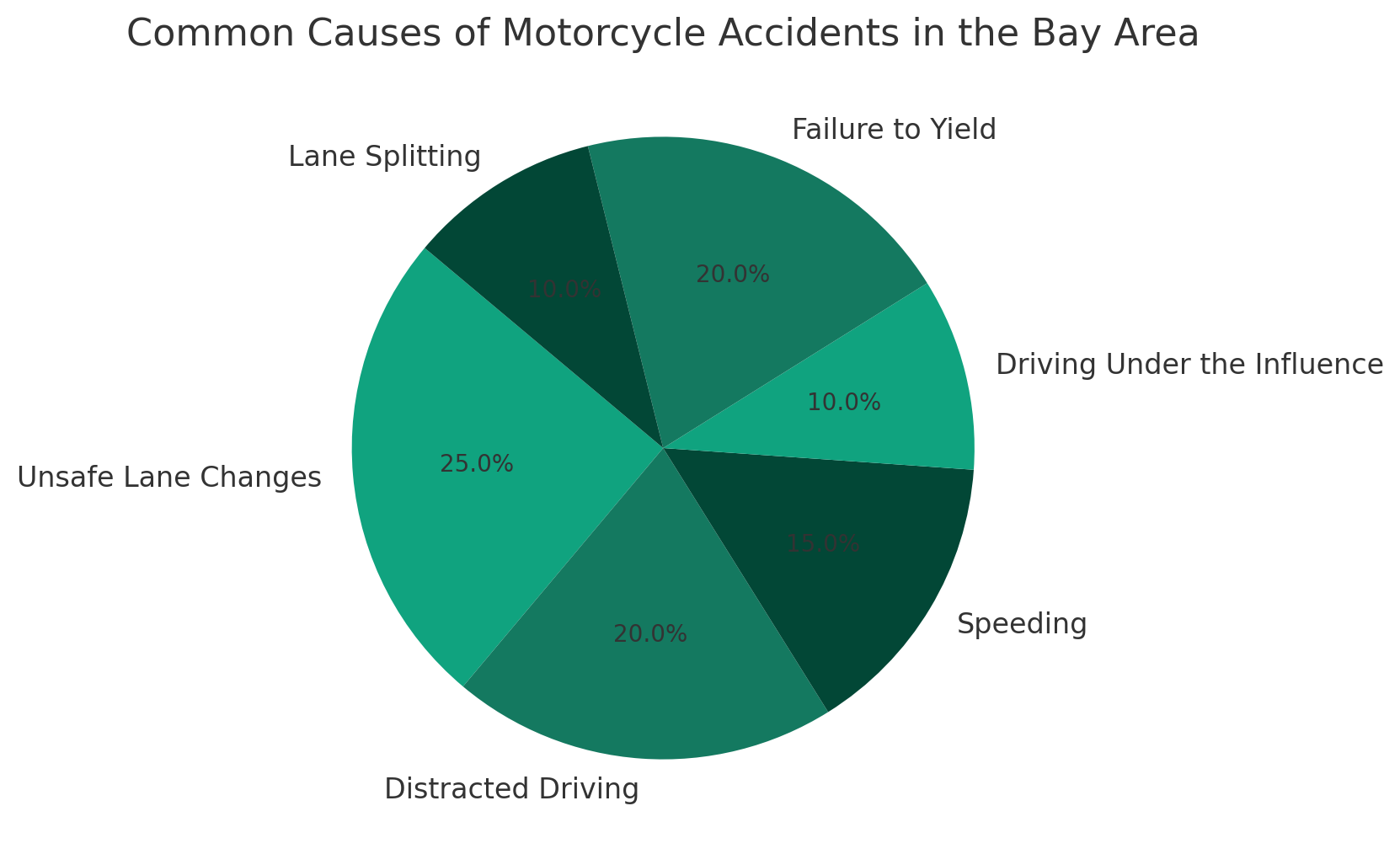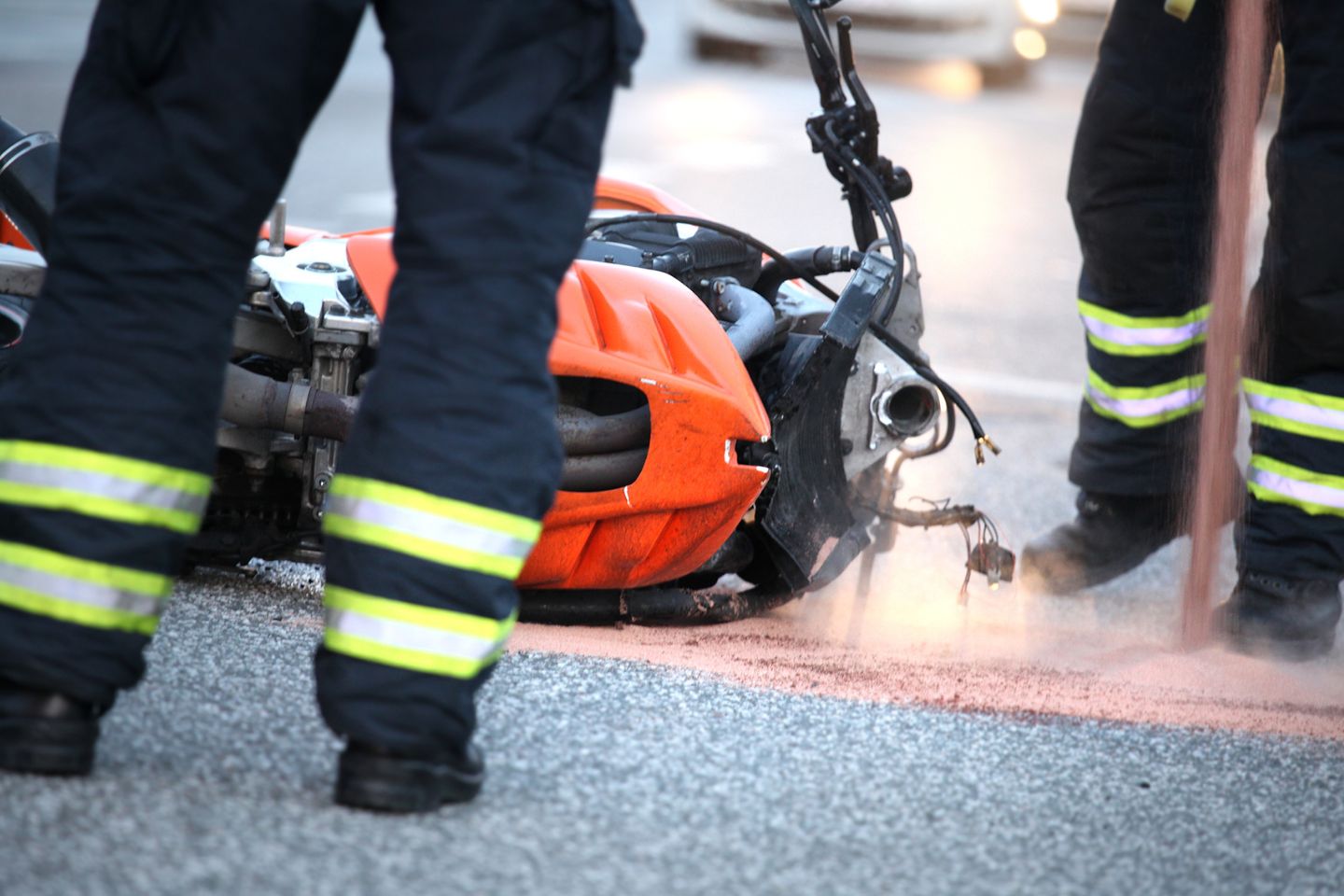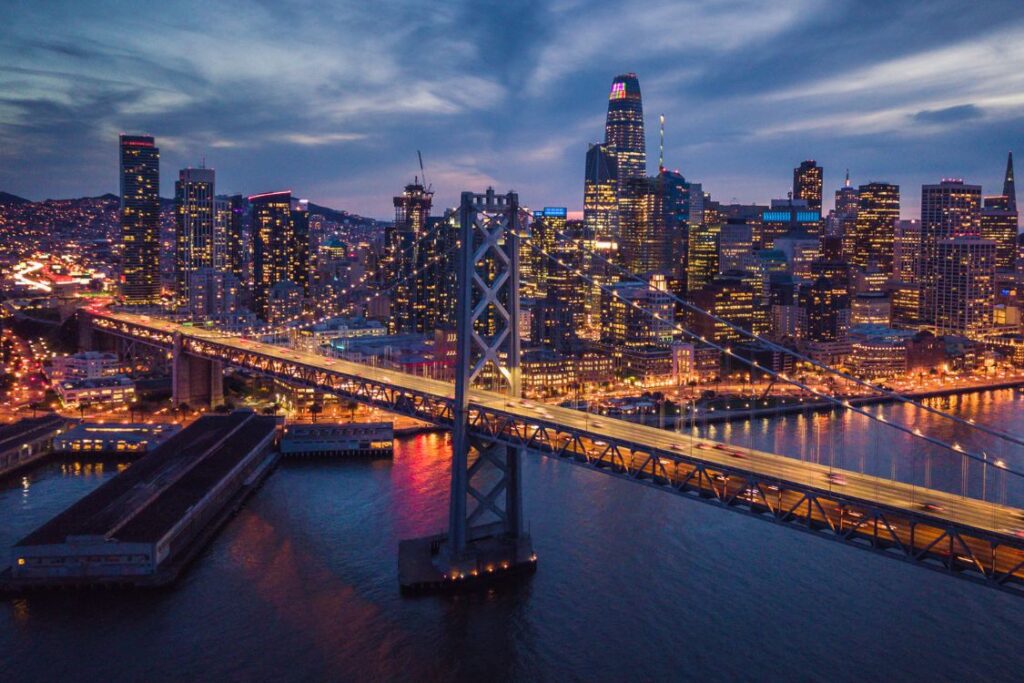Motorcycle accidents in the Bay Area have become a point of notable concern for both traffic authorities and the riding community. The dense traffic and diverse road conditions in the region present unique challenges that riders may not encounter in less populated areas. The consequences of these accidents range from minor property damage to severe injuries or even fatalities.
With the Bay Area’s ever-expanding urban environment and its growing population leading to busier roads, motorcycle safety is increasingly crucial. The collective effort towards enhancing rider education and road safety awareness is essential to decrease the frequency and impact of these accidents. Riders must remain informed about the inherent dangers of motorcycling, while lawmakers and safety organizations continue their work to better protect the motorcycling community.
- Overview of Motorcycle Accidents in the Bay Area
- Common Causes of Motorcycle Accidents in the Bay Area
- Impact of Motorcycle Accidents on Bay Area Traffic and Safety
- Preventative Measures for Riders
- Statistical Analysis of Motorcycle Accidents
- Medical Implications of Motorcycle Accidents
- Technological Advancements in Motorcycle Safety
- Frequently Asked Questions
Overview of Motorcycle Accidents in the Bay Area
A teeming region, the Bay Area is prone to more traffic and accidents including motorcycle accidents. Motorcycle crashes are comparatively more dreadful due to the exposed nature of riders and the high speeds on freeways like Interstate 80 and Highway 101.
Recent reports have underscored the dangers for motorcyclists on these routes. For instance, a multi-vehicle crash on Interstate Highway 80 in Berkeley resulted in a motorcyclist’s fatality. Similar incidents have been noted in other parts of the Bay Area, such as Santa Teresa Boulevard in San Jose, where a motorcyclist was killed in a collision with a vehicle.
Motorcycle safety in the region has been an ongoing concern because dense traffic, complex roadways, and often-foggy conditions can create precarious situations for even the most experienced riders. The traffic authorities are working tirelessly to make improvements and the region safer for riders. They monitor and report incidents to better understand patterns and causes.
In light of these concerns, it becomes imperative for motorcyclists to adhere to safety measures like wearing helmets and protective gear, and for other motorists to be vigilant in sharing the road responsibly. Awareness campaigns and improved roadway designs are part of the concerted efforts to reduce the frequency and severity of these accidents.
Here’s a summary of recent incidents:
- Hesperian Blvd / Lewelling Blvd, Hayward: Collision with ambulance responding.
- Sr49 / Old Foresthill Rd, Auburn: Hit and run with no injuries reported.
- Highway 101, Northbound past San Antonio Road, Redwood City: Fatality after motorcycle collided with multiple vehicles.
- Interstate 580, Oakland: Motorcycle crash causing traffic delays.
The data signifies a need for ongoing safety measures and education for both riders and drivers in the Bay Area.
Common Causes of Motorcycle Accidents in the Bay Area


Motorcycle accidents are a common occurrence in the Bay Area and there are various factors that can be attributed to both motorcyclists and drivers of other vehicles as a cause of accident.
Unsafe lane changes are a primary cause as vehicle drivers may fail to check their blind spots or signal before changing lanes, leading to collisions with motorcyclists who may be in their path.
Distracted driving has went on to become another main cause of motorcycle crashes. Activities that divert a driver’s attention from the road, such as using a smartphone, adjusting the radio, or eating, increase the risk of not noticing a nearby motorcycle.
We mention a few other causes of motorcycle accidents below.
- Unsafe Lane Changes: Not checking blind spots or signaling.
- Distracted Driving: Phone usage, eating, or other distractions.
- Speeding: Exceeding speed limits reduces reaction times.
- Driving Under the Influence: Alcohol or drugs impair judgment and motor skills.
- Failure to Yield: Not respecting a motorcyclist’s right of way during turns.
Issues related to visibility such as a driver failing to check their blind spot and responsiveness are a requisite for motorcycle safety.
Lastly, lane splitting, which is legal in California but can be hazardous if not done safely, often results in accidents when drivers are unaware of motorcyclists’ movements between lanes. Riders and drivers alike need to exercise caution and vigilance to prevent these common causes of motorcycle accidents in the Bay Area.
Impact of Motorcycle Accidents on Bay Area Traffic and Safety
Ever since motorcycle accidents in the Bay Area have been increasing, considerable traffic disruptions have become a norm and raised various concerns about road safety as well.
Traffic Congestion and Road Closures
Traffic congestion and road closures can last for days as a result of horrendous motorcycle accidents. For instance,a recent accident in the Bay Area caused severe delays, as roads are often partially or fully blocked until cleared by emergency crews.
Emergency Response and Accident Investigation
A typical aftermath of a motorcycle accident involves an emergency response to address injuries and an in-depth investigation to determine cause. Such accidents can stress the capacity of local emergency response teams, especially when they occur during peak hours, highlighting the importance of efficient coordination and communication among first responders.
Long-Term Traffic Safety Initiatives
In the Bay Area, efforts to address long-term traffic safety for motorcyclists have been elevated through the means of public awareness campaigns and improved roadway designs. They help to prevent accidents and their subsequent impact on traffic flow and safety.
Legal Considerations for Motorcycle Accidents in the Bay Area
If you or someone you know has been in an unfortunate motorcycle accident in the Bay Area, it is important that you know and understand the legal considerations as navigating personal injury claims, dealing with
Personal Injury Claims
In case you are a victim of a motorcycle accident in the Bay Area, there’s a possibility that you may be entitled to compensation for damages. Injury claims can address medical expenses, lost wages, pain and suffering, and more. A claim must be filed within the statute of limitations, which in California is generally two years from the date of the accident.
Insurance Claims and Disputes


California follows a fault-based system, meaning the person responsible for the accident bears the financial burden. Considering the fact that disputes often arise over settlement amounts, handling insurance claims can be complex. Therefore, it is essential to seek accomplished legal assistance.
Motorcycle Laws and Regulations
California has specific laws and regulations governing motorcycle use. Helmets are mandatory, and lane splitting, while legal, comes with conditions. Non-compliance can affect claim outcomes. It’s imperative to stay informed about these laws to best protect one’s rights after an accident.
Preventative Measures for Riders
If the below mentioned preventive actions are taken, motorcycle accidents can substantially reduce and the roads of the Bay Area will become safer for riders.
Safety Gear and Equipment
Wearing the right safety gear is the first step to ensuring your safety and avoiding a mishap on the road. It includes wearing a DOT certified helmet
Wearing is crucial for motorcyclists. is fundamental as it can save lives and reduce the risk of head injuries. In addition to helmets, riders should wear:
- Jackets and Pants: Preferably made from abrasion-resistant materials such as leather or reinforced synthetics.
- Gloves: To improve grip and protect hands.
- Boots: Sturdy footwear that covers the ankle for protection and grip.
- Eye Protection: Whether part of the helmet or separate goggles, to protect against debris and improve visibility.
Defensive Driving Courses
Defensive driving courses hone a rider’s skills and improve their ability to anticipate and react to hazards. These courses usually teach techniques such as:
- Effective Braking: How to use both front and rear brakes properly.
- Evasion Maneuvers: How to safely avoid obstacles.
- Cornering: Proper techniques for handling curves.
Riders are encouraged to seek advanced training, which can be beneficial in enhancing their ability to react to road hazards effectively.
Awareness Campaigns and Community Outreach
Awareness campaigns and community outreach programs play a pivotal role in educating both riders and drivers about motorcycle safety. For example, promoting the “Look Twice” campaign can increase driver awareness of motorcyclists on the road. Engaging in community outreach can help in:
- Spreading Safety Messages: Sharing crucial information about respecting motorcycle space and visibility.
- Promoting Safe Riding: Encouraging riders to stay vigilant and sober while riding.
By focusing on these initiatives, the likelihood of accidents can be significantly diminished, creating a safer environment for all who share the road.
Statistical Analysis of Motorcycle Accidents


This section focuses on the empirical data concerning motorcycle accidents within the Bay Area, its connections to environmental factors, and contrasts these statistics with other regions.
Bay Area Motorcycle Accident Statistics
The Bay Area sees a significant number of motorcycle accidents annually, with data indicating that San Francisco averaged nearly 8 fatal motorcycle accidents per year over a recent five-year span. A startling peak occurred in 2021 with 13 deaths, though a slight reduction in fatal incidents was noted in 2022. For a deeper understanding of these trends, San Francisco Motorcycle Accident Study includes more details.
Correlation With Weather and Road Conditions
Weather and road conditions have a tangible influence on motorcycle accident rates. The Bay Area’s diverse climate, with its wet winters and foggy conditions, can increase the risk for motorcyclists. Data linking specific weather patterns to accident frequency is critical for developing safety strategies. Evidence suggests that wet roads and limited visibility are common contributing factors.
Comparative Analysis with Other Regions
When compared to other California counties, San Francisco County ranks 15th in motorcycle fatalities. This is relatively low considering the traffic volume, especially when contrasted with Los Angeles County, which has the highest recorded fatalities. California Traffic Safety Quick Stats offer a broader comparison and show how statewide data reflects regional variances in motorcycle accident statistics.


Medical Implications of Motorcycle Accidents
In addition to physical impairment, motorcycle accidents can also harm one’s mental being. It must be taken into account that the injuries can be prolonged and may require immediate and/or long-term care.
Common Injuries and First Aid
Injuries Sustained:
- Fractures: Common in the limbs and pelvis
- Road Rash: Severe skin abrasions requiring immediate cleansing
- Head Injuries: Helmets reduce risk, but concussions are possible
First Aid Steps:
- Call emergency services immediately
- Do not remove the rider’s helmet unless necessary
- Apply pressure to bleeding wounds
- Avoid moving the injured person unless necessary for their safety
Long-Term Medical Care
Rehabilitation Needs:
- Physical therapy for motion restoration and strength building
- Surgeries may be needed for severe fractures or internal injuries
- Regular follow-ups to monitor healing progress
Support Devices:
- Casts, braces, or slings for broken bones
- Wheelchairs or crutches for mobility
- Specialized equipment for home and vehicle modifications
Mental Health Support for Accident Victims
Psychological Consequences:
- Post-Traumatic Stress Disorder (PTSD) can emerge after traumatic events
- Depression and anxiety are common post-accident feelings
Support System:
- Professional counseling is often necessary
- Support groups provide community understanding
- Ongoing therapy may be needed depending on the severity of the trauma
Technological Advancements in Motorcycle Safety
With significant developments over the years, motorcycle safety has greatly been improved.
Innovations in Motorcycle Design
A modern feature in the motorcycles is the integration of Anti-Lock Braking Systems (ABS), which helps maintain control during sudden stops, decreasing the chance of a crash due to wheel lockup.
Advancements in Protective Gear
The protective gear has been upgraded too as manufacturers now produce helmets that greatly protect a rider’s head in the event of an accident.
Smart Technology for Accident Prevention
With the use of embedded electronic systems, dynamic traction control and stability control systems assist riders in maintaining balance and control in a variety of road conditions. Moreover, airbag systems integrated into riding gear deploy upon collision, offering an additional layer of protection.
Key Takeaways
|
Frequently Asked Questions
Dealing with a motorcycle accident and its corollary can be consuming for a victim because of this victims must understand their rights and take steps they need to ensure a just recovery.
What steps should you take immediately after being involved in a motorcycle accident?
After a motorcycle accident, one should ensure safety by moving away from traffic if possible and seek medical attention even if injuries aren’t immediately apparent. Documenting the scene and exchanging information with any other parties involved is critical for future claims.
Who can be held liable in a motorcycle accident involving another vehicle?
Liability in a motorcycle accident can fall on the other driver if they were negligent, such as by violating traffic laws or driving distracted. In certain cases, a manufacturer or municipality could also be held accountable for defective parts or unsafe road conditions.
What are common injuries sustained from motorcycle accidents?
Motorcycle accidents frequently result in injuries like road rash, fractures, traumatic brain injuries, and spinal cord injuries. The severity can vary significantly, affecting the victim’s quality of life and financial stability.
How does helmet use affect the outcome of a motorcycle accident case?
Helmet use can significantly influence the outcome of a motorcycle accident case; wearing a helmet shows a commitment to safety, which may affect the compensation amount. However, in the Bay Area, not wearing a helmet doesn’t necessarily preclude victims from receiving compensation due to comparative negligence laws.
What compensation might be available to victims of motorcycle accidents?
Victims of motorcycle accidents may be eligible for compensation that covers medical expenses, lost wages, pain and suffering, and property damage. Each case is unique, and the specifics of what is recoverable can vary based on the circumstances of the accident.
How can a motorcycle accident attorney assist in the legal process following an accident?
A motorcycle accident attorney can offer comprehensive support by investigating the accident, assembling necessary evidence, and negotiating with
If you have been in a motorcycle accident in the Bay Area, suffered injuries then do not delay anymore and reach out to The Personal Injury Center for assistance. We will support you during these testing times as we associate you with the proficient legal experts who will provide guidance through the legal process, and tirelessly advocate for the compensation you deserve. To begin your restorative journey and seek justice, contact us today on the toll free number 1-800-846-2321!



